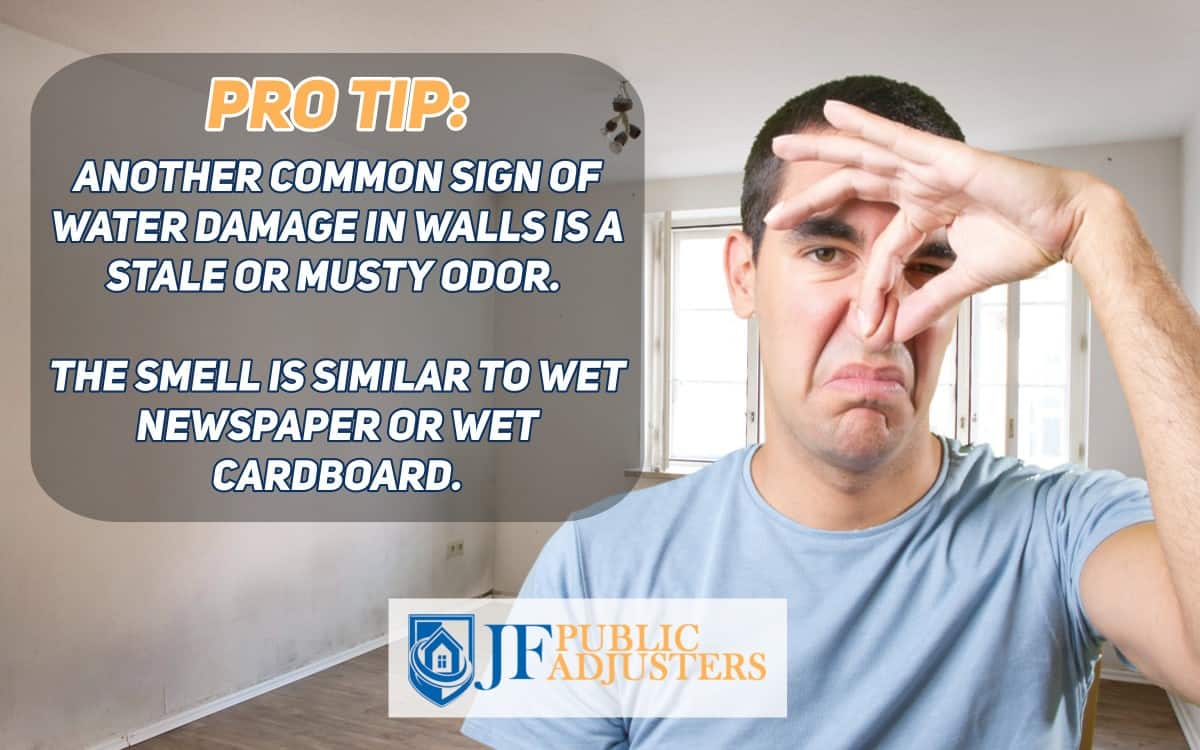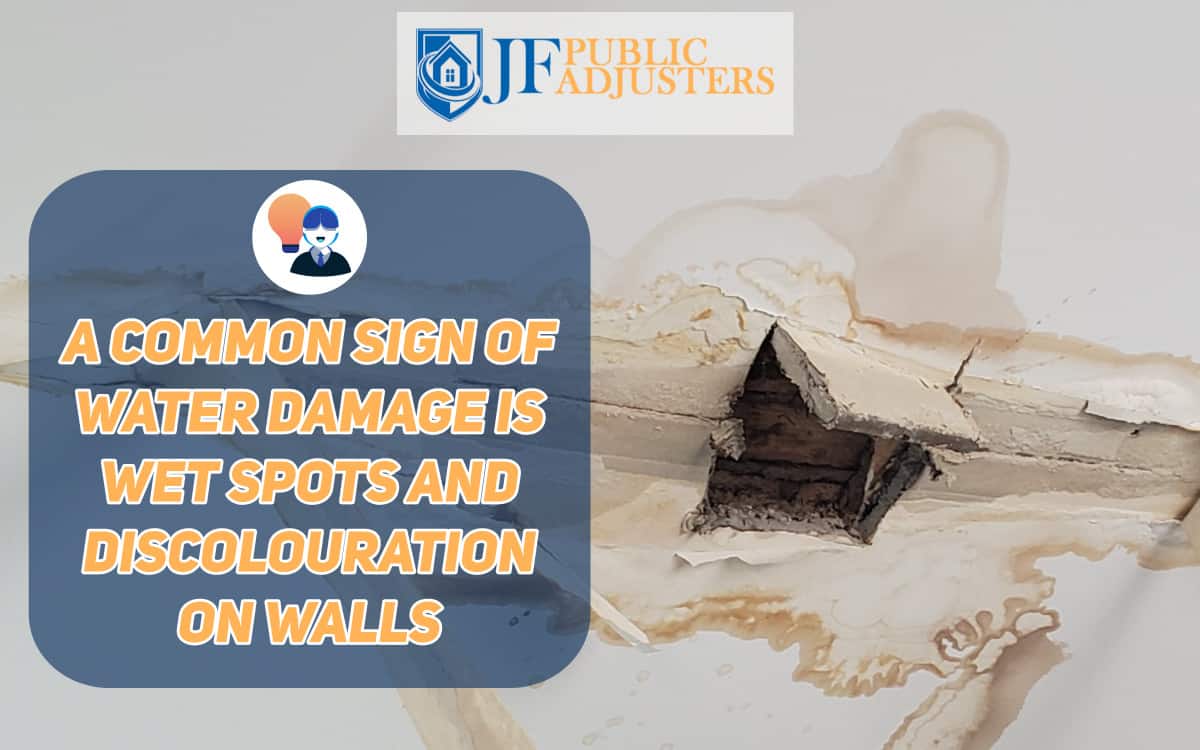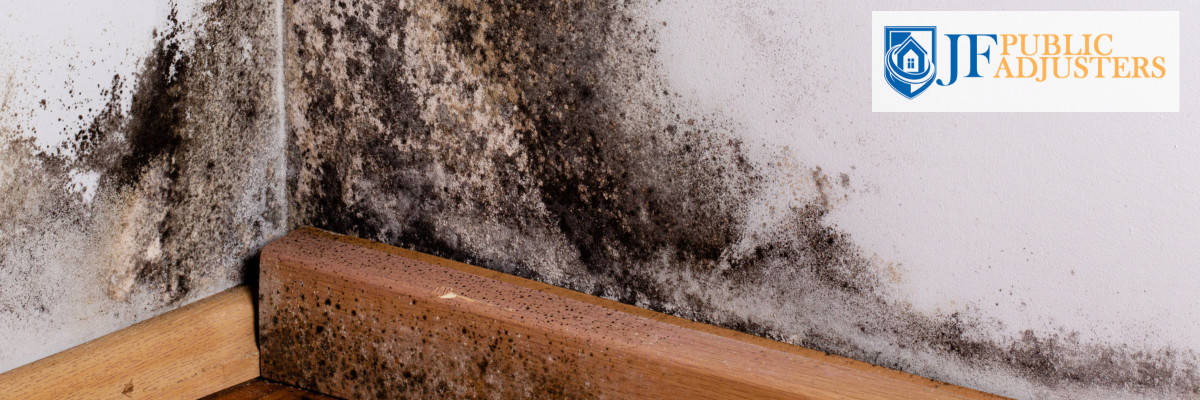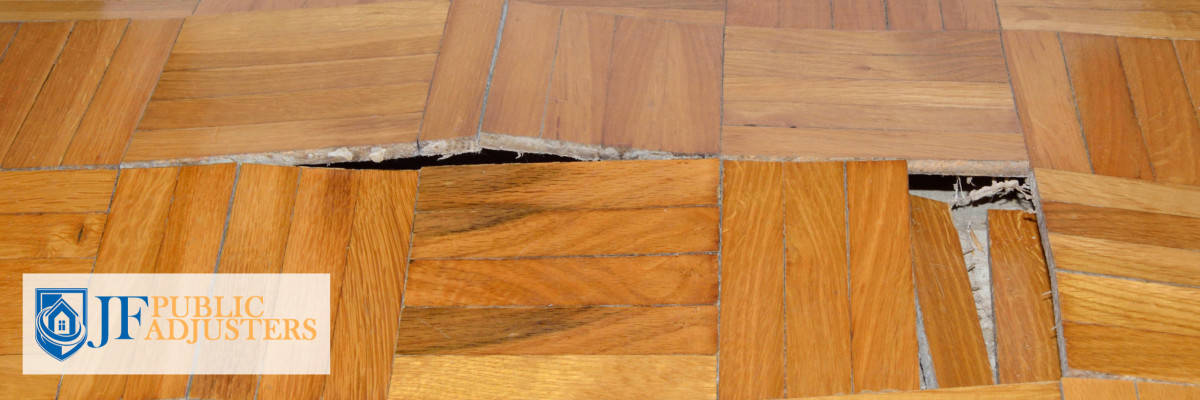Wondering about common signs on water damage in walls? Keep reading, we’ve got you covered.
Of all the claims US homeowners made on their property insurance in 2017, water damage was one of the leading ones.
The fact that the average claim for water damage that year was about $10,000 is worrying.
It shows how much water damage can cost you as a homeowner if you hesitate to identify the signs and act immediately.

The only way to ensure you mitigate water damages in your home is by detecting faults early enough to prevent worse outcomes.
Read on to learn about some of the common signs of water damage in walls from our local public adjusters here at JF Public Adjusters.
1. Wallpaper/Paint Bubbling or Cracking
When water consistently leaks into a wall, it causes it to expand. In the process, the collected water underneath the paint on your walls stretches the paint or wallpaper, leading to paint bubbling on the wall. The expansion and contraction of the wall are what leave these bubbles.
Although bubbles are easy to identify, whatever is behind them is what should worry you most. That’s because these bubbles cannot help you determine the extent of water damage on your wall.
For small bubblers, you can use towels to help mitigate the impending disaster. You’ll block any more water from flowing through the hole.
On the other hand, large water bubbles may be beyond you. You’ll need to call in a professional who can deal with the large volume of trapped water accordingly, helping minimize the extent of the damage.
But whether the bubbles are big or small, the best thing is to contact water damage restoration professionals. They can help address the destruction these bubbles may have caused on your walls.
2. Musty Smell
Another common sign of water damage in walls is a stale or musty odor.
Walls impacted by water damage typically has a very distinct smell making pretty tough to miss.
It smells like wet newspaper or wet cardboard.
At the exact point where the smell emanates from, you may feel some dampness. Assess that area, checking for any other sign of water damage, such as wet spots, soft spots, dark spots, stains or molds.
If the musty odor occurs just after winter or heavy rain, this could indicate issues with your foundation.
If there’s a musty smell in your drywall, wood, or sheetrock, it may be a sign that there’s water leakage behind it. Don’t wait for the visible signs of wall damage such as mold and mildew to appear. Instead, correct the situation instantly.

3. Water Stains/Discoloration
Water stains or discoloration is a clear indicator there’s a burst or leaking pipe. It could also be that the roof lets water seep into the drywall. A musty smell may also accompany the stains.
Light brown or dark yellow spots or lines are a sure sign of water damage on your walls or ceilings. If you don’t fix the leaking pipe immediately, the condition will only worsen, and getting rid of the stains will be quite a task.

4. Signs of Mold or Mildew
It’s hard to separate mold and water because it thrives where there is persistent wetness.
For this reason, you may need to check your drywall, ceiling, carpeting, or wood for signs of mold damage and mildew. It may be the most obvious indication of a water leak in the wall if you spot any.
To save your home, remove that water as soon as possible.

Remember, mold is not at all pleasant, and it poses serious health threats. It appears in many different colors ranging from black mold to green, to blue, grey and white mold as well. If you don’t deal with mold fast, you’ll be surprised at how quickly it breeds.
5. Structural Issues and Changes
When water collects behind the walls, it causes structural damage to the ceilings and floorboards.
So, as soon as you notice structural problems such as cracking, inspect for water damage. Otherwise, there might be a pending disaster behind those cracks related to the bubbling, cracking, or flaking of wall paint or wallpaper.
6. Warping Walls
If drywall absorbs too much water, it caves, causing your entire wall to warp.
You should look at the wall, but also keep an eye out for ceiling water damage as well.
The wall and nearby ceiling may also sag.
As soon as you see this, know that a lot of water damage is already happening. With the sagging, warping, and even sogginess, your ceiling may even end up falling.
Therefore, it’s best to find a solution immediately to prevent further damage in your home and even potentially destroy your household.
7. Floor Damage
Signs of water damage in walls vary depending on the type of floor you have.
In many cases, wet flooring is obvious
If it’s wooden, you may observe buckling. This is easy to identify if you carefully compare it with the adjacent floor level.
Note that you may not immediately notice the damage before the water has receded. But later, you’ll see that the floorboards pushed some nails up.
Linoleum may buckle as well as curl up around its edges, while carpeted flooring can feel wet and produce a squishing sound when you walk on it.

8. Alarming Increase in Your Water Bills
So your family routine is still the same, but the bill shoots up. Something is not adding up. Chances are, you have some plumbing issues. Probably, water is leaking or running water has been left on somewhere in your walls.
If you can check your water meter, do that first. Next, check your bathrooms and toilets to ensure no faucet is leaking. Afterward, you can go from one appliance to another, checking for leaks.
Here is a list of places to check for hidden leaks if you see a sudden increase in the water usage on your utility or water bill:
- Faucets and sinks
- Toilets
- Hoses
- Laundry rooms
- Washing Machines
- Basements and Pipes (If visible)
- Water Heater
- Water Pumps
If everything is okay, look for any of the above signs of water damage on your walls. Somewhere behind your drywall, there must be a leak that needs fixing before it’s too late.
9. Softened Drywall
Water damage on walls may cause your drywall to soften. Often, this is a sign that most people don’t notice. The softening occurs due to water soaking the backside of your home’s drywall, but the front side appears normal.
If you’re suspicious of water in walls, press against the drywall to check for softened areas. If the wall becomes depressed or buckles, then this is a clear sign of a water-damaged wall.
Like earlier mentioned, it’s hard to identify softening on walls. Therefore, mold and mildew may grow after prolonged dampness. So stay vigilant of any growth, musty odors, or rotting, and if you notice anything, move with speed to mitigate the mold damage.
10. Outdated Pipes and Plumbing Fixtures
Plumbing fixtures and pipes are often installed behind walls, where it’s hard to see them and identify faults. While most pipes are long-lasting and capable of lasting a lifetime, connections, valves, and faucets are prone to damage or wear and tear over time.
Regularly inspecting all visible plumbing fixtures helps you identify signs of leakage. Also, since most pipes pass through the walls, by listening against the wall, you may hear strange sounds indicating potential water issues.
A dripping sound or the sound of running water are sure signs of a problem. If you can’t hear anything, try listening for the sound of water running at night when ambient noise is at it lowest.
Whether it is a burst pipe or just a minor leak, fixing it in a timely manner is critical. So you’ll want to call for repairs immediately.
Remember, drips landing on your concrete floor will form holes, affecting the stability of your home. Therefore, be vigilant and inspect your sinks and toilets to ensure drain pipes and water supply are in proper condition.
Are your cabinets wet or moldy? That’s a sure sign of water damage, which you need to repair immediately to prevent it from spreading further.
Finally, check the caulk around your sinks and bathtub. Caulk is an affordable, quick fix that’s essential for preventing mold growth and water damage. If the device wears out or gets damaged, then leaking water may have already gotten behind your walls.

What Next After Spotting Signs of Water Damage?
The question on your mind now is what next after identifying signs of water damage in the walls.
Well, at first, the damage may not be that serious to warrant professional help. Therefore, you can use your basic skills in water piping and connections to check for previous or current leaks and repair them. Also, dry the walls to remove the excess moisture.
Most homeowners go wrong in waiting until the problem gets worse, even after identifying several signs of water-damaged walls, before seeking help.
While it’s understandable to worry about the repair costs, remember the more you wait, the worse the water damage gets. In the end, you’ll spend a lot more on burst pipes and other extensive repairs. Therefore, the best thing to do is to act after you identify signs of water damage.
How to Dry Walls After Water Damage
The first step after identifying dripping water is to repair the leak and dry out the wall.
Drying out involves using towels and a dehumidifier. Run the dehumidifier while blotting the walls to remove excess water. Proceed with caution because excessive pressing may collapse softened drywalls.
Next, call in a professional to assess the extent of any other damage and offer viable solutions. That way, you make your home safe.
Final Word on Water Damage Signs
Water damage can result in severe structural damages to your home.
Nobody wants to spend so much on repairs and restorations because of a water leak.
Fortunately, you now know the most common signs of water-damaged walls to look out for.
Remember, most insurance companies will not consider your claim if it’s due to water damage, especially where it spells negligence on your part.
Keep in mind, water leaks left unaddressed, can get more expensive to repair the damage in your home
Therefore, don’t wait for the damage to get catastrophic before you can repair your home.
In many cases, especially if there is extensive damage to the affected wall, you will require the assistance of a water damage restoration company.
Preventing water damage starts with knowing what to look for.
Be a proactive homeowner who keeps checking their home for signs of water damage in walls, searching for any hidden leak, wet walls or dark spots, paying attention to spot signs of bad plumbing hardware which could lead to a leaky pipe, signs of moisture or any other signs of damage in your home.
Another suggestion is to make your family members at your house or any other of the home’s occupants aware of what they should be looking for which could identify a previous or current leak which could damage your house.
That way, you may never have to break the bank to cover extensive repairs that you could have avoided.
Sources
source https://jfpublicadjusters.com/blog/signs-of-water-damage-in-walls/